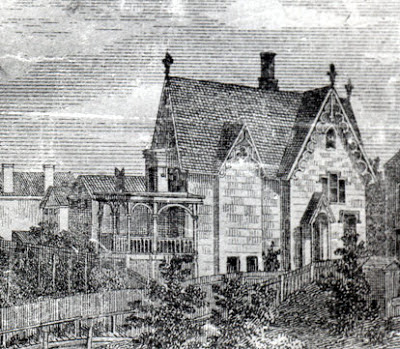On Friday, the Historic Preservation Commission held a public hearing on the exterior metal stairs proposed for entrances on the south and west facades of the historic Charles Alger house, 59 Allen Street.
Before the HPC heard public comment, Walter Chatham, the architect for the Galvan project, presented "an architectural progression" of historical stairways to justify the choice of metal stairs. He argued that, at the time the house was constructed, iron and steel were being introduced as building materials, and since Charles Alger, believed to be the one for whom the house was constructed, was one of the founders of the Hudson Iron Works, it would be completely logical for his house to have metal stairs. Alger himself, Chatham suggested, might chosen to have metal stairs on his house. Chatham also defended the metal stairs by saying that it was the hope that the simple design, with open risers, would make the stairs transparent, to highlight the restored limestone facade below the water table.
Matt McGhee, the only person to speak during the public comment period, said he had done research similar to what Chatham had done to justify the proposed stairs, and in no case did he find such a "stark steel staircase." He argued that the staircases on this house would have been wood or stone. He cited the Gothic design of the railing that survives that the main entrance to house and asserted that this should be replicated on the staircases at the other entrances.
In his comments, McGhee brought up a problem with the restoration as it has so far been completed: the tripartite window in the east facade.
The 1858 engraving of the house shows that the drip moulding was at the top of the three windows, stepped to trace the different heights of the three parts of the window.
The elevations presented to the HPC, which were the basis for granting the certificate of appropriateness, show the drip moulding at the top of the three parts of the window, just as it appears in the 1858 engraving.
So why does the drip moulding over these windows, as it was recently done, follow the shape of the relieving arch? A relieving arch, also called a displacing arch, is a structural element intended to support the weight of the wall above the window lintels, lessening the weight of the brick wall on the window frames. There is evidence that the relieving arch was not meant to be visible and certainly not meant to be highlighted with a drip moulding.
Commenting on Friday, McGhee wondered if the window was finished or not. "I don't know what's intended," said McGhee, "but as it stands, it's incorrect." It seems that "as it stands" is what Galvan considers finished, but one doesn't need documentation to recognize that what was done just looks wrong, not to mention the proportions of the new windows are different from what appears in the 1858 engraving. The center section is much taller in relation to the sections on each side.
It remains to be seen if the HPC will order Galvan to correct the drip moulding to make it match the historic evidence and the rendering that was presented.
COPYRIGHT 2023 CAROLE OSTERINK







So far, i would greatly applaud Walter Chatham with his detailed work on the restoration of this beautiful structure. It once was decaying.
ReplyDeleteWith respect to the modification of the three part window issue, I like the solution and do not think it in any way interferes with the whole. the new window must give in better light into the interior. the arch seems elegant.
All in all, Hudson is lucky that this much has been spent to restore this masterpiece.
At a certain point, nitpicking over minute renovation details starts to seem like harassment.
ReplyDeleteIn historic preservation, as in so many other things, God is in the details.
Delete"order Galvan to correct the drip molding"? Can they do that? What is the penalty if Galvan doesn't change it? Would a C of O not be issued? I was always under the impression that the HPC was a consulting body that didn't have legal authority to impose any type of fine or penalty.
ReplyDeleteYour impression is incorrect, Wowser. The HPC does have legal authority. They can and they have exercised their legal authority, which is not a fine but an order to redo what was done without a certificate of appropriateness or in violation of the conditions of the certificate of appropriateness.
Delete